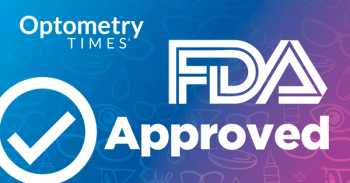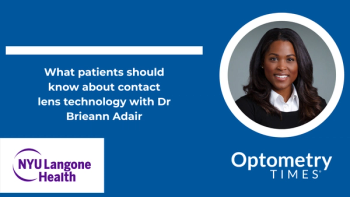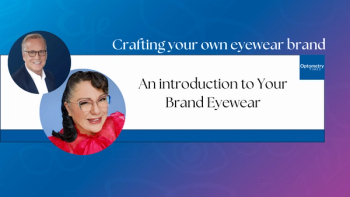
Don’t be afraid of steroids
Ron Melton, OD, FAAO, and Randall Thomas, OD, MPH, FAAO, discussed common practices for treating dry eye, meibomian gland dysfunction (MGD), and blepharitis at the American Optometric Association (AOA) annual meeting. Here are a few medical management pearls from their discussion.
Boston-Ron Melton, OD, FAAO, and Randall Thomas, OD, MPH, FAAO, discussed common practices for treating dry eye, meibomian gland dysfunction (MGD), and blepharitis at the American Optometric Association (AOA) annual meeting. Here are a few medical management pearls from their discussion.
Treating dry eye, MGD
Past literature has encouraged that clinicians use compresses and anti-inflammatory therapies for patients with mild cases of MGD-but to use steroids only for the most severe cases. The thought that steroids should be reserved as a last line of defense is what Dr. Thomas says is “absolutely foolish and not patient centric.”
Related:
There is also a common practice that clinicians uncomfortable with prescribing steroids may want a second opinion from a cornea specialist.
“Do you understand how profoundly stupid that is?” Dr. Thomas asked.
“Actually, cornea specialists send [those patients] to me,” Dr. Melton agreed.
An attentive, compassionate optometrist is the most qualified clinician to care for patients with dry eye disease and MGD, they said.
Expressing meibomian glands
Physical, mechanical expression of meibomian glands is what Drs. Melton and Thomas recommend as the best treatment for patients. Fifteen sustained seconds of pressure on the lids, paired with heating pads and warm compresses, is key for clinicians to see what, if any, discharge comes out.
Devices such as Lipiflow are available for putting an exact amount of pressure on a specific area of the lid. Because meibomian glands are in the posterior portion of the eyelid, heat the glands for about 12 minutes, beginning from the inside. Then, use the device to express the contents of the glands. This diagnostic maneuver can help determine the stage of the disease and if thermal treatment is the appropriate treatment option.
Related:
Devices such LipiFlow are slowly decreasing in costs and becoming more practical for consumer price points, Dr. Melton says.
Commercially available heating pads are also very helpful. Dr. Melton is extremely aggressive in encouraging warm compresses for his patients. If patients keep up with the compresses, it can drastically reduce symptoms of dry eye, he says.
Future of meibography
Meibographers are critical to assess the quality of meibomian glands.
“OCT has radically changed the landscape of eye care,” Dr. Thomas says. He thinks every optometrist should own one, and he predicts meibography will be a routine part of practice over the next decade.
Golf club massage technique
Until you can access the glands, it is hard to know where a patient sits on the dry eye continuum.
Using a golf club spud, a simple scraping of the lower lid has been shown to loosen orifices and improve comfort of patients with MGD.
The scraping massage should be followed up with warm compresses and blinking exercises.
“Do you understand how profoundly simple this is?” Dr. Thomas says. “There is no procedure code for this. This will take you 10 seconds if you’re slow.”
Combination topical therapeutics
There are four main categories of combination drugs which include prednisolone, dexamethasone, loteprednol, and hydrocortisone.
Few clinicians use prednisolone, according to Drs. Melton and Thomas, and they believe that only older general practitioners use hydrocortisone because it is so weak.
The gold standard for years was a combination of tobramycin and dexamethasone (TobraDex, Alcon) which is a guard against prolonged used of dexamethasone. This combination also offers excellent coverage against most ocular pathogens while effectively suppressing inflammation.
The only problem, Dr. Thomas says, is that the steroid with the highest propensity to increase intraocular pressure (IOP) is dexamethasone. Because of that, he is not a big fan of it. However, he is a fan of the price point of the neomycin, polymyxin B, and 0.1% dexamethasone (Maxitrol, Alcon) combination.
“I can get this in my area for $6 or $8,” he says. “I’m a huge fan of cheap. If you don’t think your patients are, ask them-they’re [bigger fans] than you.”
This combination is what Dr. Thomas prescribes the most, using it almost every day in his practice.
Addressing chronic blepharitis
For chronic blepharitis that is uncontrollable, Dr. Melton uses the combination tobramycin 0.3% and loteprednol etabonate 0.5% (Zylet, Bausch + Lomb). He prescribes it four times daily for a few weeks, then twice daily for a month or two. He also advises warm compresses.
Hygiene is critical in these cases.
Epithelial breakdown flares
Dr. Melton recalls a patient who had a history of flare-ups that were very painful.
“If it’s really painful, it normally means there is corneal involvement,” Dr. Melton said.
Epithelium breakdown in the cornea needs to be treated with steroids, not antibiotics, he said, adding that if it is at or near the limbus, it is inflammatory and not an infection.
Steroids vs. antibiotics
Chemotactic leucocytes are inflammatory white blood cells that inflame the cornea and break down the epithelial cells.
Dr. Thomas describes this as “a retrograde demise of the epithelium because of the underlying stromal inflammation.”
He encourages using steroids in these cases with no reservations because the patient will not improve otherwise.
“We were taught to avoid using steroids if you’ve got corneal breakdown,” says Dr. Melton.
“Unless you know the cause of the corneal breakdown,” continues Dr. Thomas, who says it’s often due to the corneal inflammation.
“American people are suffering because of timidity, ignorance, or incompetence,” he says.
To prevent recurrences, Dr. Melton puts patients on doxycycline at 50 mg twice daily for a few weeks, then 50 mg daily for a few months. He also encourages using warm compresses.
“Ninety-five percent of all acute red eyes are inflammatory, so to add an antibiotic because you’re scared or not sure…you’re going to lose every time because chances are patients need a steroid, and you’re giving an antibiotic,” Dr. Thomas say.
Playing devil’s advocate, Drs. Melton and Thomas say the worst case scenario is that what you are seeing is an early stage of a corneal ulcer and the patient is put on tobramycin and dexamethasone. The tobramycin would take care of the bacteria in that case, anyway.
“So even when you’re wrong, you’re right,” Dr. Thomas says. “It’s at the limbus so it needs a steroid.”
He said clinicians can be confident in doing this, especially considering that the number one reason for optometrists being successfully sued in America is failure to diagnose.
“We don’t get sued for doing stuff,” he said. “We get sued for missing stuff.”
Newsletter
Want more insights like this? Subscribe to Optometry Times and get clinical pearls and practice tips delivered straight to your inbox.



















































.png)


